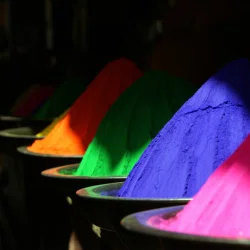Metallic Pigments: Enhancing Products with a Lustrous Finish
2024-09-29
Metallic pigments have taken the world of manufacturing, cosmetics, and arts by storm, adding a luxurious and striking appeal to various products. From glossy automotive finishes to shimmering makeup palettes, these pigments offer a unique way to make colors more vibrant and reflective. In this blog, we'll explore what metallic pigments are, their applications, and why they're such a popular choice across industries.
What Are Metallic Pigments?
Metallic pigments are finely powdered metals or metal compounds, usually made from aluminum, bronze, or copper, that create a reflective, shiny appearance when mixed with paint, ink, or other mediums. Unlike regular colorants, which simply add hue, metallic pigments also impart a metallic sheen or sparkle, giving a sense of depth and movement. This makes them particularly popular in industries that value aesthetic appeal and high-end finishes.
Types of Metallic Pigments
There are several types of metallic pigments, each with its own unique properties and applications:
1. Aluminum Pigments: Known for their bright, silver-like appearance, aluminum pigments are widely used in automotive paints, packaging, and industrial coatings. They provide a sleek, modern finish with excellent reflective qualities.
2. Bronze and Copper Pigments: These pigments offer a warmer, more antique-like shine, making them a favorite in arts, crafts, and cosmetics. Their rich golden and copper hues are often used to create luxurious looks in home decor and beauty products.
3. Pearlescent Pigments: While technically not metallic, pearlescent pigments mimic the look of metal by reflecting light in a way that creates a pearl-like shimmer. These pigments are widely used in makeup and nail polish to achieve a subtle, glowing finish.
Applications of Metallic Pigments
1. Automotive Industry
The automotive industry has long embraced metallic pigments for car paints, providing vehicles with a glossy, high-end appearance. The metallic finish also enhances the vehicle's visibility by reflecting light, making it a practical choice for both safety and style. The pigment particles scatter light, creating a dynamic effect that changes based on the angle of viewing and the surrounding light conditions.
2. Cosmetics
Metallic pigments are popular in the beauty industry, particularly in products like eyeshadows, lipsticks, and nail polishes. They give makeup a shimmering, bold look that catches light and adds dimension. With metallic pigments, a simple swipe of eyeshadow can turn into a dazzling, high-impact look perfect for parties or dramatic makeup styles.
3. Inks and Printing
Metallic pigments are used in the printing industry to create eye-catching packaging, advertisements, and printed materials. Whether it's for product labels, brochures, or luxury packaging, the use of metallic pigments adds a premium look that stands out. These pigments are often combined with other inks to create sophisticated designs with metallic accents, making brands look more upscale and exclusive.
4. Art and Craft Supplies
In the world of art, metallic pigments have long been a favorite for adding detail and depth to paintings, sculptures, and decorative items. Artists use metallic pigments to bring out highlights, create textures, or add a touch of glamour to their work. Metallic paints and powders are also used in crafting to create DIY projects that have a polished, professional appearance.
Benefits of Metallic Pigments
1. Enhanced Aesthetic Appeal
Metallic pigments immediately elevate the visual appeal of a product by adding a touch of luxury and sophistication. Whether it’s a metallic-finished car or a shimmering lipstick, the reflective quality of these pigments creates a high-end look.
2. Versatility
Metallic pigments can be mixed with a wide range of materials, including paints, plastics, cosmetics, and printing inks. Their ability to blend seamlessly into different mediums makes them extremely versatile for various industries.
3. Durability
In many applications, metallic pigments not only improve aesthetics but also add durability. For example, in automotive coatings, the reflective qualities of metallic pigments can protect underlying materials from UV radiation and weathering, thus extending the life of the paint.
Conclusion
Metallic pigments are an excellent way to add luster, depth, and luxury to almost any product or project. Their versatility, combined with their ability to reflect light and create eye-catching designs, makes them a favorite across a variety of industries. Whether you're in manufacturing, cosmetics, or art, metallic pigments offer endless possibilities for enhancing the visual appeal of your work.



